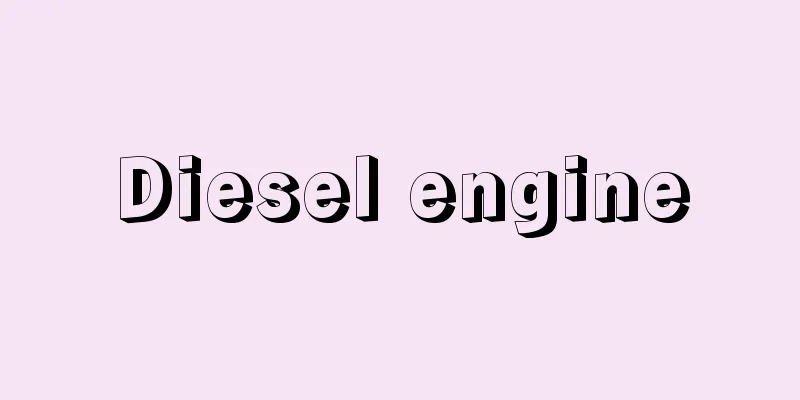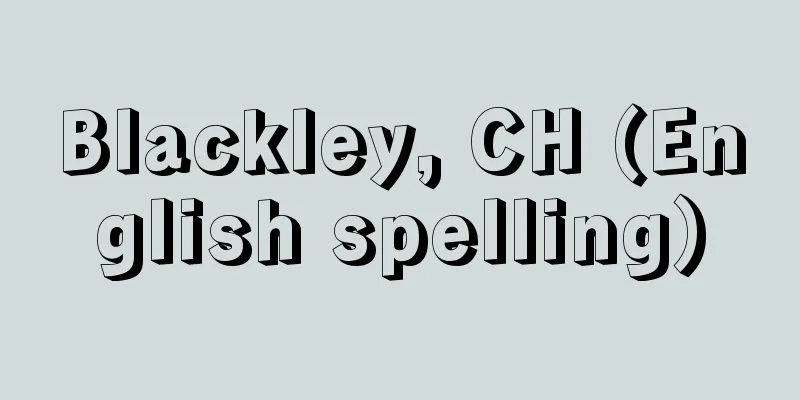Diesel engine

|
A reciprocating internal combustion engine that uses petroleum fuels (kerosene, diesel, heavy oil, etc.) that have lower vaporizability than gasoline and cannot be easily vaporized in a carburetor. [Masatake Yoshida] historyGerman engineer Rudolf Diesel invented this in 1893, but the technology to make an engine with a high compression ratio had not been established, and it was not built until 1897. This engine had a side valve, and the fuel was injected into the cylinder with high pressure air. It was heavy to withstand high compression, and because it required compressed air to inject the fuel, its use was limited to stationary use. Later, the valve arrangement became overhead valve type, and the thermal efficiency improved, and it came to have the same performance as a large Otto gas engine. Around 1905, G. Brandsetter developed an airless injection pump system that injects only fuel without using high pressure air, which was later improved and mass-produced by Robert Bosch from around 1930. This pump eliminated the need for an air compressor, and was widely used in small diesel engines. When applying the two-stroke system to diesel engines, it was promising because it only required air for scavenging, and there was no risk of backfire, which occurs in two-stroke gas engines. Around 1920, the Swiss company Sulzer manufactured two-stroke diesel engines of around 3,000 kilowatts for power generation. After that, large engines of over 1,000 kilowatts for power generation and large ships became two-stroke diesel engines. All of these had scavenging air pumps, and crankcase compression engines were almost nonexistent among large two-stroke diesel engines. Around 1893, the same year as Diesel, Hugo Junkers of Germany created a two-stroke diesel engine (called an opposed-piston engine) in which opposing pistons at both ends of a cylinder move synchronously toward the center to compress the air and burn fuel injected in the center. Air is taken in at one end of the cylinder and exhausted at the other end. Because gas flows in one direction inside the cylinder, it is also called a uniflow engine. This engine was used widely for a long time, including for airplanes, due to its high efficiency. Scavenging blowers were mechanically driven positive displacement or turbo compressors, and supercharging was rarely used. Later, in order to obtain higher power output and higher thermal efficiency, turbochargers driven by exhaust turbines were put to practical use, and currently large two-stroke diesel engines with high-pressure supercharging have a thermal efficiency of close to 50%, with an output of about 6,000 kilowatts per cylinder. Large diesel engines use heavy oil as fuel, but medium and small diesel engines use diesel oil, which is easy to ignite, in order to increase the rotation speed, and small automotive diesel engines have an output of about 200 kilowatts and a maximum rotation speed of 4,500 revolutions per minute. [Masatake Yoshida] structureThe basic structure of an engine consists of a cylinder, a cylinder head, pistons, a crankshaft, a connecting rod (also called a conrod), a camshaft, an intake and exhaust valve mechanism, and a flywheel. The fuel supply system consists of a fuel supply pump, a fuel filter, a fuel injection pump, and a fuel injection valve. In most engines, a high-pressure fuel injection pipe connects the fuel injection pump and the fuel injection valve, and the pump's plunger is driven by a cam. When the fuel pressure reaches a certain level, the injection valve opens automatically, overcoming a spring. There are two types of pumps: a row type with a plunger for each cylinder, and a distribution type in which compressed fuel from a small number of plungers is supplied to the injection valve of each cylinder by a distributor. There are also some integrated injection devices in which the pump and the injection valve are integrated and driven by a cam, which allows for very high injection pressures. In particular, for automobiles, computer-controlled injection devices that enable injection at ultra-high pressures and can be controlled with high precision and freedom have been playing a leading role since the end of the 20th century in order to purify exhaust gas and improve thermal efficiency. In this system, fuel is sent from a high-pressure fuel supply pump to a fuel pipe (called a common rail) common to all cylinders, and the amount of fuel specified by the computer is injected from each cylinder's electronically controlled injection nozzle at the specified time and pattern. The fuel is injected into the combustion chamber. In a single-chamber engine where the combustion chamber is surrounded by the cylinder, cylinder head, and piston top, this is called a direct injection system. In a pre-chamber engine where the combustion chamber consists of another combustion chamber (called a pre-chamber) in the cylinder head connected to the combustion chamber by a communication port, the fuel is injected into the pre-chamber. This is called an indirect injection system. Direct injection is mainly used to purify exhaust gas and improve thermal efficiency. Unlike gasoline engines, diesel engines do not have an intake throttle valve, and always draw in sufficient air into the cylinder, compressing it to about one-twentieth of its volume, and the air temperature is 500 to 700°C. Fuel is injected into this high-temperature, high-pressure air, vaporizes, and spontaneously ignites, so output is adjusted by the amount of fuel injected. The lubrication system, which sends lubricating oil between the piston and cylinder and to the bearings of each part, consists of an oil pump, oil filter, and oil reservoir. Large diesel engines in particular use lubricating oil to cool the pistons, and have a lubricating oil cooling system. In most water-cooled engines, the cooling system consists of a water circulation pump, a radiator (air-cooled and water-cooled), and a temperature regulator, and large marine diesel engines may be cooled directly with seawater. Many small engines have a high-temperature thermal plug as an ignition source when the cylinder is cold at start-up and the injected fuel does not vaporize well. In large engines, especially those that use heavy fuel oil with low fluidity, a fuel preheating system is used. Modern diesel engines are available in both four-stroke and two-stroke varieties, with single-acting and double-acting pistons (with combustion chambers on both sides of the piston). Most small engines for automobiles and agricultural use, such as tillers, are relatively high-speed four-stroke engines, and are limited to single-acting types. Output ranges from a few kilowatts to around 200 kilowatts. Most large buses and trucks are also four-stroke single-acting. High-speed marine engines use both four-stroke and two-stroke engines, with two-stroke engines having scavenging blowers and both fitted with turbochargers. Most large marine engines are two-stroke engines, and many are highly turbocharged double-acting. Output reaches around 6,000 kilowatts per cylinder, and the number of cylinders is increased until the required horsepower is reached. There is an engine that compresses only air and injects fuel, just like a diesel engine. At start-up, a part of the combustion chamber (called a hot bulb) is heated from the outside, turned red hot, and fuel is injected into the hot bulb, which is vaporized and burned by the heat from the hot wall. This is called a hot bulb engine. Diesel engines are heavy because they are built to withstand high combustion pressure, but they can use lower quality fuel than gasoline, have high thermal efficiency, and consume less fuel, so operating costs are low. Therefore, except when output per unit weight is particularly required, they are widely used in the transportation sector, such as on ships and trucks. In addition, because of their high thermal efficiency, they have low CO2 emissions, so new diesel engines that combine high-pressure supercharging, exhaust gas recirculation, and exhaust gas treatment have been widely used as passenger car engines since the beginning of the 21st century to purify exhaust gas and combat CO2 emissions. [Masatake Yoshida] "Automotive Engineering Encyclopedia 5: Diesel Engines" edited by Tsutomu Saito (1980, Sankaido)" ▽ "The History of Internal Combustion Engines, New Revised Edition, by Kiyoshi Tomitsuka (1984, Sanei Shobo)" ▽ "Diesel Engines and Automobiles: Shadows and Lights, Origins and Future, by Takashi Suzuki (2008, Miki Shobo)" ▽ "John Robert Day Engines; The Search for Power (1980, The Hamlyn Publishing Group Ltd.)" [Reference] | | | |©Shogakukan "> Diesel engine structure (two-stroke low-speed engine) Source: Shogakukan Encyclopedia Nipponica About Encyclopedia Nipponica Information | Legend |
|
燃料として、ガソリンよりも気化性が悪く、気化器では容易に気化できない石油燃料(灯油、軽油、重油など)を用いる往復動内燃機関。 [吉田正武] 歴史1893年ドイツの技術者ルドルフ・ディーゼルが考案したが、高圧縮比の機関をつくる技術が確立されておらず、1897年にいたって製作された。この機関は側弁式で、燃料は、高圧空気でシリンダー内に噴射される空気噴射であった。高圧縮に耐えるために重い機関になり、燃料を噴射する際に圧縮空気を必要とするため用途は据付け用に限られていた。その後、弁配置が頭上弁式になってから熱効率も高くなり、大型オットーガス機関と同等の性能をもつようになった。1905年ごろにブランドセッターG. Brandsetterが開発した高圧空気を用いない燃料だけを噴射する無気噴射ポンプ方式はその後改良され、ロバート・ボッシュ社によって1930年ごろから量産された。このポンプを用いると空気圧縮機は不用になり、小型のディーゼルエンジンに多く用いられた。2行程方式をディーゼルエンジンに適用する場合、掃気は空気だけでよく、2行程ガス機関でおこる逆火の心配もないため有望であった。1920年ごろにはスイスのズルツァー社が発電用の3000キロワット程度の2行程ディーゼル機関をつくっていた。その後、発電用、大型船舶用の1000キロワット以上の大型機関が2行程ディーゼルエンジンになった。これらはすべて掃気用の空気ポンプをもち、クランク室圧縮の機関は大型2行程ディーゼルエンジンではほとんどない。 ディーゼルと同じ1893年ごろドイツのヒューゴ・ユンカースHugo Junkersは、一つのシリンダーの両端にある対向したピストンが同期して中央に向かって動いて圧縮し、中央で噴射された燃料が燃焼する2行程ディーゼルエンジン(対向ピストンエンジンといわれる)をつくった。吸気はシリンダーの一端で行われ、排気は他端で行われる。ガスがシリンダー内を一方向に流れるのでユニフローエンジンともいわれる。このエンジンは高い効率のため飛行機用も含めて長く広く使用された。 掃気用送風機は機械駆動の容積型またはターボ圧縮機で、過給はあまり行われなかった。その後、より高出力を得るためと高い熱効率を得るために、排気タービンで駆動するターボ過給機による過給が実用化され、現在では高圧過給による大型2行程ディーゼルエンジンは熱効率50%に近く、1シリンダーで6000キロワット程度になっている。燃料は大型ディーゼルエンジンでは重油であるが、中型、小型ディーゼルエンジンでは、回転数を高くするため、着火性のよい軽油を用いており、小型自動車用ディーゼルエンジンでは200キロワット程度の出力で最高回転数が毎分4500回転に達している。 [吉田正武] 構造基本構造は、シリンダー、シリンダーヘッド、ピストン、クランク軸、コネクティングロッド(コンロッドともいう)、カム軸、吸排気弁機構、はずみ車などからなる。燃料供給装置は、燃料供給ポンプ、燃料フィルター、燃料噴射ポンプ、燃料噴射弁からなる。多くは燃料噴射ポンプと燃料噴射弁の間を高圧用の燃料噴射管でつなぎ、ポンプのプランジャーをカムで駆動し、噴射弁は所定圧力になると、ばねに打ち勝って開く自動弁である。ポンプは、気筒数だけプランジャーのある列型と、少数のプランジャーから圧縮された燃料を分配器で各気筒の噴射弁に供給する分配型がある。また一部にはポンプと噴射弁が一体になりカムで駆動される一体型噴射装置があり、非常に高い噴射圧力を可能にしている。とくに自動車用では排気浄化と熱効率向上のために、20世紀末ごろから超高圧力での噴射を可能にし、噴射を高精度かつ自由に制御できるコンピュータ制御の噴射装置が主役になっている。この装置では高圧の燃料供給ポンプから全シリンダーに共通の燃料パイプ(コモンレールという)に燃料が送られ、各シリンダーの電子制御の噴射ノズルから、コンピュータで指示された燃料量が指示された時期とパターンで噴射される。燃料は燃焼室に噴射される。燃焼室がシリンダー、シリンダーヘッド、ピストン頂部に囲まれた単室式機関の場合、直接噴射式といわれる。また燃焼室が前記燃焼室のほかに連絡口でつながっているシリンダーヘッド内の燃焼室(副室という)からなる副室式では、燃料は副室に噴射される。これを間接噴射式という。排気清浄化と熱効率向上のために直接噴射が主になっている。 ガソリンエンジンと異なり、吸気絞り弁はなく、つねにシリンダー内に十分に空気を吸入し、容積比で20分の1程度に圧縮し、空気の温度も500~700℃になる。燃料はこの高温高圧空気中に噴射され気化し、自発点火するので、出力は燃料噴射量で調整する。潤滑装置は、ピストンとシリンダーの間、各部のベアリングなどに潤滑油を送るもので、油ポンプ、油フィルター、油溜(あぶらだめ)からなる。とくに大型ディーゼルエンジンではピストンの冷却にも潤滑油が用いられ、潤滑油冷却装置をもつ。冷却装置は、多くの水冷式の場合は水循環ポンプ、ラジエーター(空気冷却のものと水冷のものがある)、温度調整器からなり、大型船舶用ディーゼルエンジンでは海水で直接冷却する場合がある。始動時のシリンダーが低温で、噴射された燃料の気化が悪いときの点火源として高温の熱栓をもつ機関が小型機関に多い。大型の機関でとくに流動性の低い重油を用いる機関では燃料の予熱装置を用いる。 現在のディーゼルエンジンには4行程式と2行程式の両方があり、ピストンも単動式と複動式(ピストンの両側に燃焼室をもつ)がある。自動車用、耕うん機など農業用の小型機関では4行程の比較的高速の機関が多く、単動式に限られる。出力は数キロワットから200キロワット程度である。大型バス、トラック用でもほとんどが4行程の単動式である。船舶用の高速機関では4行程機関と2行程機関がともに使用され、2行程機関は掃気送風機をもち、両方とも過給機を取り付けている。大型の船舶用エンジンはほとんどが2行程機関で、高過給の複動式も多い。出力は1シリンダーで6000キロワット程度に達し、必要な馬力に達するまで気筒数を多くする。 ディーゼルエンジンと同じように空気だけを圧縮し、燃料を噴射する機関がある。これは、起動時に燃焼室の一部(焼き玉(だま)といわれる)を外から加熱、赤熱状態にし焼き玉の中に燃料を噴射し、高温の壁からの熱で気化燃焼させるもので、焼き玉機関とよばれる。 ディーゼルエンジンは、高い燃焼圧力に耐えられるように強くつくられるので重くなるが、ガソリンより低質の燃料が使用でき、熱効率が高く、燃料消費量が少ないので運転経費が安い。したがって、単位重量当りの出力がとくに要求される場合を除いて船やトラックなどの輸送分野で広く用いられている。また、熱効率が高いためにCO2排出率が小さいので、排気清浄化とCO2対策で乗用車用エンジンとして高圧過給、排気再循環、排気処理などを組み合わせた新しいディーゼルエンジンが、21世紀初めごろから広く使用され始めた。 [吉田正武] 『斉藤孟監修『自動車工学全書5 ディーゼルエンジン』(1980・山海堂)』▽『富塚清著『内燃機関の歴史』新改訂版(1984・三栄書房)』▽『鈴木孝著『ディーゼルエンジンと自動車――影と光 生い立ちと未来』(2008・三樹書房)』▽『John Robert DayEngines ; The Search for Power(1980, The Hamlyn Publishing Group Ltd.)』 [参照項目] | | | |©Shogakukan"> ディーゼルエンジンの構造(2行程低速機… 出典 小学館 日本大百科全書(ニッポニカ)日本大百科全書(ニッポニカ)について 情報 | 凡例 |
Recommend
Nyoirin Kannon - Nyoirin Kannon
One of the Kannon Bodhisattvas. Its Sanskrit name...
Naojiro Ota - Naojiro Ota
...A writer of the late Edo period. Author of kyo...
Kannongatake
...A mountain located in the western part of Yama...
Photometer
...The term photometer is generally used, but thi...
Parsua
… [history] The Persians, along with the Medes, b...
Alcohol lamp - Alcohol lamp (English spelling)
A heating device used as a small heat source. Alc...
Inverted U hypothesis
…Income inequality is often measured in the secon...
Marechal, L.
… In the end, Latin American literature reached i...
Iwashiro Province
This province was established on December 7, 1868...
Britannia Royal Naval College
...The site of the facility is currently used by ...
Eland - Eland (English spelling)
It is also called the eland or the big eland. It ...
Aldermaston
A village in central Berkshire, southern England, ...
Cartoon
〘 noun 〙 (cartoon) ① A life-size sketch (for a mur...
Tintoretto - Tintoretto (English spelling)
Italian painter. His real name was Jacopo Robusti...
Mandatory Lawsuit - Gimzuke Sosho
A lawsuit seeking to order an administrative agenc...









